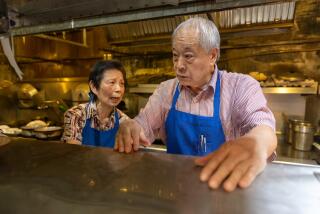Exhibit Offers Largely Untold Tale of Chinese Settlers in L.A.
- Share via
Visitors to El Pueblo Gallery on Olvera Street keep asking why it is presenting a landmark exhibit on early Chinese settlers in the historically Mexican neighborhood.
Curator Suellen Cheng said they are surprised when she explains that Olvera Street--known as the birthplace of Los Angeles--was by the 1870s also home to Chinese immigrants.
“Mexicans and Chinese lived and worked side by side,” she tells visitors. “Mexicans went to Chinese butchers for fresh meat and frequented Chinese herb doctors.” Some Chinese and Mexicans married and raised families.
Those and other stories are told in the free exhibit “From Hearth to Heaven: Chinatown Living,” which is open daily from 10 a.m. to 4 p.m. until next Sunday. It offers a rare glimpse into how Chinese pioneers lived and worked, telling previously untold stories of the city’s original Chinese families through photographs and artifacts.
The exhibit was produced by the Friends of the Chinese American Museum and El Pueblo de Los Angeles Historical Monument, the city entity that oversees Olvera Street.
Since the show opened last month, more than 10,000 people have viewed photos of homes where settlers lived, the businesses they ran, the clothes they wore, crops they grew and tools they used. The purpose is to offer a slice of Los Angeles’ past that is not often acknowledged in classrooms or textbooks, and to nurture a deeper understanding of the city’s multicultural legacy.
Some of the most satisfied customers at the exhibit are schoolchildren.
“I thought it would be boring, but it was very interesting,” said Krysten Blacksher, a fourth-grader at El Rancho Elementary School in Chino, who came last week on a field trip with her class.
“They prayed differently,” said Lizet Zepeda, another fourth-grader, after viewing photos of temples where Chinese Buddhists worshiped.
“They grew crops,” said Blanca Santiago. “They were smart and they worked hard--and they danced.”
Their teacher, Barbara Sandberg, said the timing of the exhibit couldn’t have been better.
Her pupils are studying the Gold Rush era and will soon start learning about construction of the transcontinental railroad. Thousands of Chinese immigrants were hired in the 1860s by the Central Pacific Railroad to work on the project.
Carrie Houston, Krysten’s mother, said the exhibit was educational for her as well.
“I’ve lived in California all my life, and I didn’t know the Chinese have been here so long,” she said. “I wish I could have been exposed to all this stuff when I was in school.”
Union Station stands on the site of the old Chinatown, which until 1930 had hundreds of buildings and businesses, several restaurants, three temples, eight Christian churches, a Chinese school and a theater for Chinese opera.
“For many, this is their first chance to understand Chinese American history,” said Cheng, an art historian. Conversations with visitors, she said, have been the most rewarding.
The exhibit contains a small portion of the more than 2,000 artifacts donated by Chinese families over the past decade for the Chinese American Museum. That facility is expected to be ready at the end of 2000, after the renovation of the nearby Garnier Building.
A tourist from Tahiti was surprised when she walked into the gallery by accident.
“I was in the Mexican section--then all of a sudden I’m in a Chinese gallery,” said Taitua Gaetjens. “Maybe the next one will be Japanese.”
“If you go a little ways, you will run into Little Tokyo,” said Peggy Wong, a retired kindergarten teacher and volunteer docent.
“I like it,” Gaetjens said, as she waved goodbye.
“What a place, this Los Angeles.”
More to Read
Sign up for The Wild
We’ll help you find the best places to hike, bike and run, as well as the perfect silent spots for meditation and yoga.
You may occasionally receive promotional content from the Los Angeles Times.






